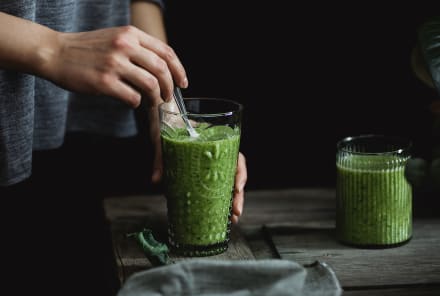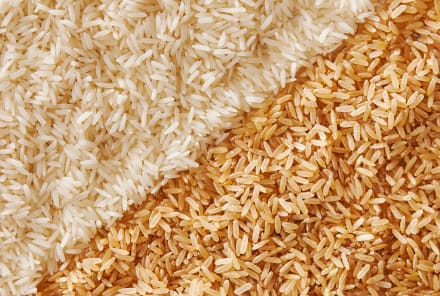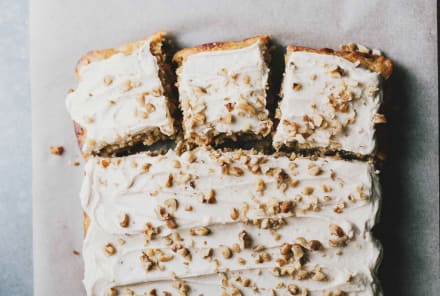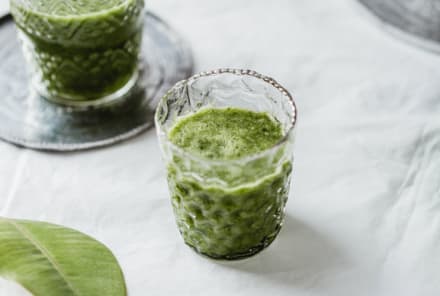Advertisement
The Absolute Best Foods For Getting That Youthful Glow

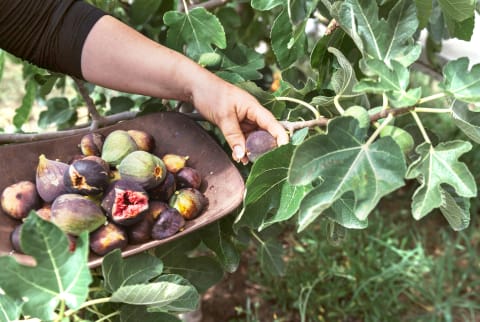
Hippocrates is famously quoted for saying, "Let food be thy medicine, and medicine be thy food," but I would argue that food can be the fountain of youth, too.
Consider this: 90 percent of visible aging is due to sun exposure, with air pollution, smoking, and stress being close seconds. Sometimes, it feels like the world is conspiring against our bodies—especially our skin. Luckily, you can use the food in your shopping cart to crowd out all the factors working against you and promote a youthful glow. This means that when you look in the mirror and see fine lines, wrinkles, uneven tone, texture, and pigmentation, you may want to take stock of how you are stocking your pantry.
Why our skin ages and what we can do about it.
Aging occurs because of two different factors: intrinsic and extrinsic. You don't have much control over intrinsic factors, which are influenced by your genes, ethnicity, and certain medical conditions. But there is a major upside because you can have a huge impact on your extrinsic factors like UV exposure, stress, smoking, nutrition and lifestyle choices, which are major contributors to the aging process.
How do these extrinsic factors contribute to aging? All of them can generate the trifecta of reactions that create fines lines, wrinkles, and skin sag: oxidation, inflammation, and glycation. When you combine these three things, you hit the jackpot for premature aging. Here's what I mean:
1. Oxidation
In your body, oxidation can be caused by molecules called free radicals. Free radicals are unstable oxygen molecules that are missing at least one of their electrons so they try to steal an electron from nearby cells in your body. This causes oxidation of that cell, resulting in cellular and DNA damage or even cell death.
While your body produces free radicals all the time as a normal part of its functioning (think: breathing, digestion, and exercise), trouble can start when you add in those extrinsic factors and your body gets overwhelmed by the quantity of free radicals. The outcome is that your body enters a state of oxidative stress where it can't fight off free radical damage on its own. Free radicals set off a chain of events in your body that begin to cause visible damage, including the breakdown of your collagen and elastin, which makes your skin wrinkle, sag, and appear thinner. Couple this with slowed collagen production as we naturally age, and you've got a perfect setup for accelerated aging.
You can't avoid free radicals altogether, but you can reduce the damage they cause with a diet rich in antioxidants. Antioxidants are the antidote to free radicals. Vitamins A, C, E, anthocyanins, beta-carotene, lycopene, zinc, selenium, and resveratrol are just a few of the antioxidants that serve to protect your skin by donating one of their electrons to the free radical so it can no longer cause damage.
2. Inflammation and glycination
All the food you eat gets converted into glucose, which is the simplest form of sugar that your body can use for energy. Foods containing more sugar—think packaged cereal, crackers, sauces as well as foods that are more readily converted into sugar like refined carbohydrates—can flood your system with glucose. This can be a problem for two reasons:
Inflammation: Your body is on a roller coaster of high and low blood sugar spikes and labile insulin levels, which can lead to skin sag, inflammation, and chronic disease. Chronic inflammation is at the root of chronic disease systemwide and your skin is no exception. Inflammation can worsen rosacea, psoriasis, and eczema and can also weaken the collagen and elastin in your skin over time, leading to skin laxity, poor wound healing, and uneven tone and texture.
Glycation: When sugar combines with protein or fat in the bloodstream, the result is the formation of harmful compounds called advanced glycation end products1 (also knowns as AGEs). AGEs can be formed spontaneously in the body or they can be formed in foods like fried foods and highly processed products like red meat, margarine, nuts, and butter. Cooking methods using high temperatures—like frying2, grilling, and toasting—can also contribute to AGEs formation.
In your skin, AGEs are formed with collagen and elastin causing these fibers, which are integral to a supple and youthful appearance, to become stiff, inflexible, and prone to breakage. Translation: Your skin becomes less elastic, wrinkled, saggy, and more vulnerable to sun damage.
How to eat for a youthful glow.
Admittedly, there are a lot of things in our food supply and environment that threaten our skin health and appearance. But I've seen time and time again in my practice that focusing on certain foods can make a huge difference:
1. Antioxidant-rich foods
Eating foods rich in antioxidants like tomatoes (lycopene), berries (polyphenols), dark leafy greens (Vitamin E), and spinach (carotenoids) can limit damage caused by free radicals and AGEs. Pair your meal with a few cups of green tea (catechins) and coffee (caffeic acid) for an added boost.
2. Anti-inflammatory foods
Adding in foods rich in carotenoid plant compounds like lycopene (tomatoes, watermelon, and guava), lutein (pumpkin, pistachio, dark leafy greens), and zeaxanthin (parsley, kale, egg yolk) will give you an anti-inflammatory and antioxidant jolt. Foods rich in zinc, selenium, and copper like lentils, eggs, dark chocolate and almonds are also vital to the formation of collagen and elastin and help decrease inflammation.
3. Anti-glycation foods
Foods that limit rapid, sharp spikes in blood sugar can help limit AGE formation. So can utilizing cooking methods using low temperatures and water-based moisture like steaming, poaching, and stewing.
Apples, asparagus, figs, celery, green peppers, cauliflower, and onions have been shown to combat the process of glycation as they are rich in phytonutrients, beneficial compounds, including rutin, quercetin, and luteolin.
Adding in high fiber vegetables like artichokes and broccoli, as well as herbs and spices including cinnamon, ginger, turmeric, garlic, sage, thyme, and fenugreek can help keep blood sugar levels steady and block collagen-damaging AGEs.
The best part of all of this is that these foods can be used in so many delicious recipes. Protecting your skin doesn't mean only eating bland, boring food. So bon appetit and cheers to long-term skin health.
Watch Next
Enjoy some of our favorite clips from classes
Enjoy some of our favorite clips from classes
What Is Meditation?
Mindfulness/Spirituality | Light Watkins
Box Breathing
Mindfulness/Spirituality | Gwen Dittmar
What Breathwork Can Address
Mindfulness/Spirituality | Gwen Dittmar
The 8 Limbs of Yoga - What is Asana?
Yoga | Caley Alyssa
Two Standing Postures to Open Up Tight Hips
Yoga | Caley Alyssa
How Plants Can Optimize Athletic Performance
Nutrition | Rich Roll
What to Eat Before a Workout
Nutrition | Rich Roll
How Ayurveda Helps Us Navigate Modern Life
Nutrition | Sahara Rose
Messages About Love & Relationships
Love & Relationships | Esther Perel
Love Languages
Love & Relationships | Esther Perel

